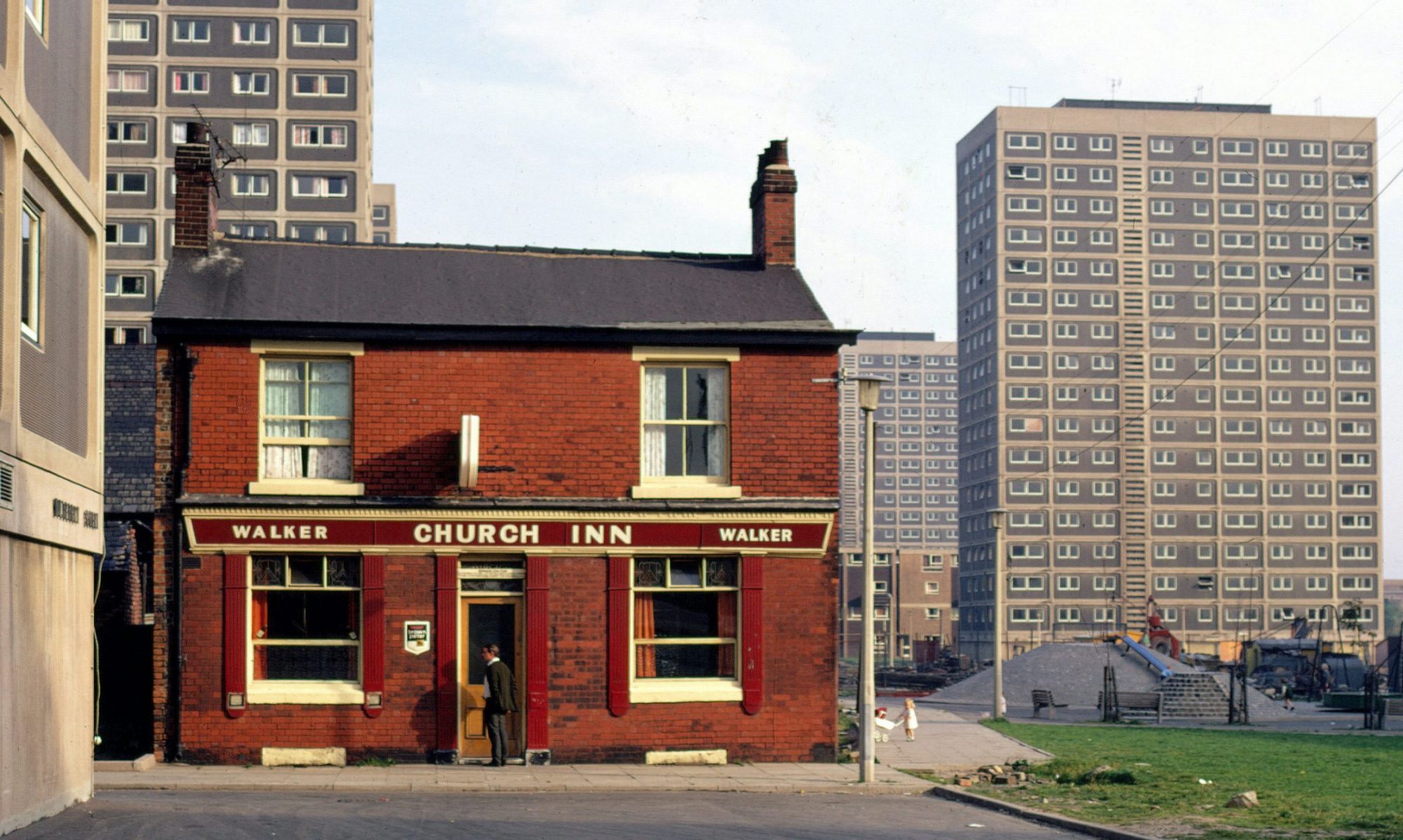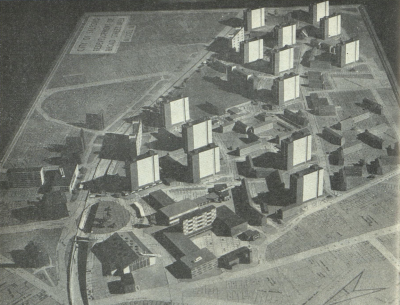
This architectural model shows a development plan that had been approved in 1960 by the City Council of Salford. It shows plans for 90 acres south of Broad Street. The plan was to provide with 2,300 dwellings in 15, 12 and 4 storey blocks. The image was published in The Architects Journal. They explain that there will be a large shopping centre (seen at the bottom of the image) with 150 shops and a lot of other infrastructure such as a swimming pool, licensed restaurant and hotel. There was also the hope:
… that the eventual redevelopment of the area will include plans for a new town hall and that this will form the nucleus of a centre which is at present entirely lacking in the city.
The proximity of Manchester’s large shopping and civic centre has prevented the rise, in Salford, of any well-defined central area to which the inhabitants are naturally attracted.
I am finding this assessment of Salford in 1960 quite interesting. It says that there was no city centre in Salford (nucleus) and that Manchester and its shops prevented Salford to grow. What I would like to know is if there ever was a 1960s built swimming pool, licensed restaurant and/or hotel in this area? Also, is their assumption about the lack of a city centre and the relationship between Manchester and Salford entirely correct? It might be perceived this way today but was it like this in the 1950s – when this plan was developed?
This is the reference to the article: Redevelopment in Salford, The Architects’ Journal (May 12, 1960) 130:3395: 722.



Thank you for this interesting blog.
‘What I would like to know is if there ever was a 1960s built swimming pool, licensed restaurant and/or hotel in this area?’
Personally, I can only go back to the 1980s. I don’t recall a hotel or a swimming pool. There were some local Victorian baths still in operation going into the 1970s. Still, it’s worth checking when Clarendon Recreation Centre was built and whether the swimming pool there was part of the plan, or deemed surplus to requirements as the pool there already existed. I suppose the offices were realised by the St James’ House development.
I don’t remember a restaurant specifically. There were some quirkier pubs, such as the Kettledrum (a circular building like The Drum in Stretford) and the Keystone (originally a prohibition-era-themed pub) that could hold functions. However, there was a place in Salford Precinct above Marks and Spencer (where Wilkinsons is now) that could be used for catered events. I was presented with an award there during a function in the mid-1980s when I was 8 years old. It was the culmination of an art competition as part of the Keep Britain Tidy campaign. Now, whether this place was originally intended to be a restaurant, I don’t know. But I imagine it could have been utilised as such.
We have to bear in mind that much of the commercial development wasn’t built until the 1970s. Possibly due to budget constraints and a scandal involving Councillor Albert Jones. Salford Precinct was certainly downscaled from the original plan. Jones wrote a memoir that might shed some light on the Broad Street/Salford Precinct development: https://www.google.co.uk/search?q=Dock+to+Dock+albert+jones&ie=utf-8&oe=utf-8.
‘It says that there was no city centre in Salford (nucleus) and that Manchester and its shops prevented Salford to grow… It might be perceived this way today but was it like this in the 1950s – when this plan was developed?’
It’s fair to say that in living memory, the perception is that Salford has never had a nucleus. Part of that may be due to how Salford expanded from the 1850s onwards. Before Salford absorbed Broughton and Pendleton – the Salford that Engels described – Salford was a thin, cigar-shaped place with Blackfriars/Trinity to the north and Ordsall to the south. A tell-tale remnant of this time is Salford railway station (now Salford Central), which is actually very close to the Manchester border. (Salford Crescent is a modern development that essentially replaced the two Pendleton railway stations.) Although Salford took in Pendleton and Broughton, and later Eccles, Swinton, Walkden, Irlam, Little Hulton etc. in the 1970s, those places already had their own identities and civic centres. It has been mooted that Eccles or Swinton could have been developed into the post-1970s city centre, but I imagine a lot of water had already passed under the bridge, so to speak.
Manchester and Salford are essentially twin cities, with Salford having always played second fiddle to Manchester. However, I don’t necessarily buy the suggestion that Manchester prevented Salford from growing. The municipal corporation would have been quite well-off in the late-nineteenth and early-twentieth centuries to do its own thing.
Also, from a leisure perspective, Salfordians didn’t necessarily rely on Manchester (or ‘town’) as they have done in the last say twenty-five to thirty years. It’s said that Salford Precinct essentially catered for the loss of all the corner shops in Hanky Park. But there was a bustling retail area on Cross Lane and (to a lesser extent) Langworthy Road that is fondly remembered. And there were pubs and social clubs aplenty down Chapel Street, Regent Road and their conjoining streets. I think you will find that a significant number of Salfordians over the age of 65 to 70 now, ventured into Manchester only occasionally because they didn’t really need or want to.
There’s a great short BBC documentary on the Hanky Park pubs in the early 1960s, which were among the last buildings to be demolished. A number of the old regulars who had since been rehomed, carried on visiting those pubs despite, in some cases, now living over 6 miles away. You can find the video at: https://bbcrewind.co.uk/asset/5ff85d95ee59ed0027557b2f?q=Salford.
This has always been the case re the lack of a City Centre. Even now, ‘Salford City Centre’ is in practice just a peripheral area of Manchester City Centre. Whereas the wider City, having swallowed up Eccles, Worsley and Swinton in the 1974 reorganisation, now has small dormitory towns that act as local shopping centres.